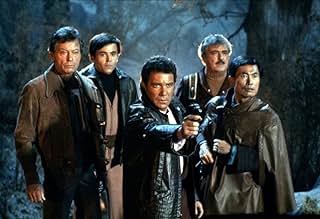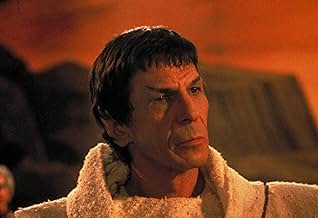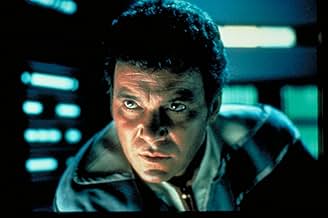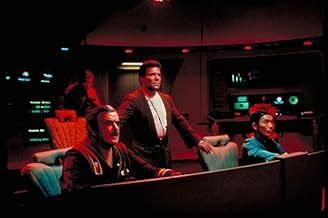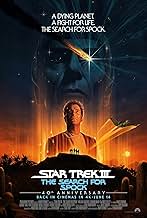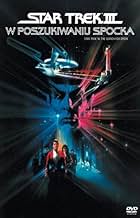Star Trek III - Alla ricerca di Spock
Titolo originale: Star Trek III: The Search for Spock
L'ammiraglio Kirk e il suo equipaggio di plancia rischiano la carriera per aver rubato la nave stellare USS Enterprise messa in disarmo per tornare sul pianeta generato dal Genesis per recup... Leggi tuttoL'ammiraglio Kirk e il suo equipaggio di plancia rischiano la carriera per aver rubato la nave stellare USS Enterprise messa in disarmo per tornare sul pianeta generato dal Genesis per recuperare la salma di Spock.L'ammiraglio Kirk e il suo equipaggio di plancia rischiano la carriera per aver rubato la nave stellare USS Enterprise messa in disarmo per tornare sul pianeta generato dal Genesis per recuperare la salma di Spock.
- Regia
- Sceneggiatura
- Star
- Premi
- 1 vittoria e 10 candidature totali
Leonard Nimoy
- Spock
- (as Frank Force)
- …
Recensioni in evidenza
It is what it is folks, it's a good honest Star Trek story, it beats a real emotive heart and although some may decry the lack of blistering space battles, or end of the universe peril scenarios, it's an essential film for dealing with the protagonists we know and love.
Into the mix here we have our favourite alien enemies The Klingons (led by the oddly cast Christopher Lloyd), Spock's father, Sarek, who adds grace to the story, and crucially Kirk gets an emotional kicker. While elsewhere hardcore fans get a big surprise with the beloved Enterprise.
It's of course merely a set up for the next (and delightfully great) instalment of Star Trek IV: The Voyage Home, but on its own terms this stands up as one of the better character pieces in the series. Due in no small part to having Leonard Nimoy directing it because he shows care and thought about a subject he obviously knows quite a bit about. 7/10
Into the mix here we have our favourite alien enemies The Klingons (led by the oddly cast Christopher Lloyd), Spock's father, Sarek, who adds grace to the story, and crucially Kirk gets an emotional kicker. While elsewhere hardcore fans get a big surprise with the beloved Enterprise.
It's of course merely a set up for the next (and delightfully great) instalment of Star Trek IV: The Voyage Home, but on its own terms this stands up as one of the better character pieces in the series. Due in no small part to having Leonard Nimoy directing it because he shows care and thought about a subject he obviously knows quite a bit about. 7/10
Picking up where "The Wrath of Khan" left off, McCoy seems to be going mad, the Enterprise is being retired, Kirk mourns the loss of Spock and his son Dr. David Marcus is off exploring his newly created Genesis planet with the lovely Vulcan vixen Saavik (exit Kirstie Alley, enter Robin Curtis). Kirk then finds out from Sarek (Mark Lenard, who had a brief, unrecognizable role in the opening of "Star Trek: The Motion Picture" as an ill fated Klingon Commander and played a Romulan before playing Spock's dad) catches up with Kirk and tells him that there's a chance at resurrecting Spock, who's mind and spirit are housed in McCoy's brain while his body is on Genesis. Feeling obligated to return the favor for saving them all at the end of #2, Kirk and the gang hijack the Enterprise and rush towards the Genesis planet to rescue Spock "in whatever form he may still be alive." Meanwhile, a bodily resurrected and rapidly re-aging Spock has been found by Saavik and David and they are stranded on Genesis after their ship is destroyed by Klingon Commander Kruge (Christopher Lloyd) and he comes looking for them in hopes of unlocking the secrets of the Genesis project, which he thinks could be used as a weapon against his people. Who will survive?
Considered by some to be trash and by others to be the only good odd numbered Star Trek film, this is a sufficiently entertaining bit of science fiction yarn that continues following the theme of what happens when you mess with mother nature. Good performances as usual, with Lloyd giving one of his best as the Klingon Commander Kruge, who becomes oddly sympathetic in light of his blood thirsty actions when you consider that he was just looking out for his own brood and was willing to spare the crew of the USS Grissom. Shatner's brawl with Lloyd is also fun to watch, and the film still has that great James Horner music. Don't miss Shatner kicking Lloyd in the face shouting "I... have HAD... enough of... YOU!"
Robin Curtis is a capable Saavik. As a bit of trivia, Saavik apparently engaged in sexual intercourse with Spock while he was going through his aging phases and, as part of an idea never utilized in the films or even in the spin off series, Saavik became pregnant with Spock's child, which was originally why she was supposed to stay on Vulcan in "Star Trek 4: The Voyage Home".
Considered by some to be trash and by others to be the only good odd numbered Star Trek film, this is a sufficiently entertaining bit of science fiction yarn that continues following the theme of what happens when you mess with mother nature. Good performances as usual, with Lloyd giving one of his best as the Klingon Commander Kruge, who becomes oddly sympathetic in light of his blood thirsty actions when you consider that he was just looking out for his own brood and was willing to spare the crew of the USS Grissom. Shatner's brawl with Lloyd is also fun to watch, and the film still has that great James Horner music. Don't miss Shatner kicking Lloyd in the face shouting "I... have HAD... enough of... YOU!"
Robin Curtis is a capable Saavik. As a bit of trivia, Saavik apparently engaged in sexual intercourse with Spock while he was going through his aging phases and, as part of an idea never utilized in the films or even in the spin off series, Saavik became pregnant with Spock's child, which was originally why she was supposed to stay on Vulcan in "Star Trek 4: The Voyage Home".
It's really a fantastic Trek movie, a bit lesser mainly because it came in the shadow of Wrath of Khan, a classic of the genre.
It's also far deeper than it appears because while the Klingons are depicted as ruthless, in fact, they are absolutely justified in being terrified at the Genesis Device.
From their point of view, the Federation has developed a weapon of astonishing power that is dressed up as a terraforming device. The evidence they have is a video showing this "terraforming" device as a torpedo, and the first use of this device is the destruction of a nebula. If you were any other power in the galaxy, would you not see this as a Tsar Bomba level demonstration of force?
If North Korea developed a terraforming device that can convert a uninhabited thousand square feet of ocean into a garden, would you not be terrified? It doesn't require any known enemy to be terrifying.
Honestly, for a long time, I wished they hadn't made Kruge so apparently blood thirsty. After time I think it works perfectly. Put the shoes on the other foot and you easily have James Bond or James Kirk himself battling to defeat this weapon.
The movie itself... I think Robin Curtis does a great job but I think her lines made more sense coming out of Kirstie Alley. Curtis plays Saavik like a straight Vulcan and her judgments of David don't really make logical sense. Alley played the half Romulan thing so her emotional judgements made more sense.
It's also far deeper than it appears because while the Klingons are depicted as ruthless, in fact, they are absolutely justified in being terrified at the Genesis Device.
From their point of view, the Federation has developed a weapon of astonishing power that is dressed up as a terraforming device. The evidence they have is a video showing this "terraforming" device as a torpedo, and the first use of this device is the destruction of a nebula. If you were any other power in the galaxy, would you not see this as a Tsar Bomba level demonstration of force?
If North Korea developed a terraforming device that can convert a uninhabited thousand square feet of ocean into a garden, would you not be terrified? It doesn't require any known enemy to be terrifying.
Honestly, for a long time, I wished they hadn't made Kruge so apparently blood thirsty. After time I think it works perfectly. Put the shoes on the other foot and you easily have James Bond or James Kirk himself battling to defeat this weapon.
The movie itself... I think Robin Curtis does a great job but I think her lines made more sense coming out of Kirstie Alley. Curtis plays Saavik like a straight Vulcan and her judgments of David don't really make logical sense. Alley played the half Romulan thing so her emotional judgements made more sense.
How does one follow a film with a fantastic villain, perfect structure, and really good special effects? Muddy the waters, apparently.
Don't get me wrong. I feel like the third Star Trek film is good, but it's also got problems.
So, let's start with the good. The Enterprise is coming home from the Mutara system, wounded with one less officer. There's no sense of victory as the ship tracks into spacedock where its wounds get pushed into a harsh light. Captain Kirk dismisses a cadet's desire for a celebration by referring to paying for their return with their dearest blood. And, on top of it, McCoy is acting odd. He breaks into Spock's sealed quarters and talks of a need to go to Vulcan. Spock's father, the Vulcan ambassador Sarek, tells Kirk of the need to bring Spock's katra, his soul, back to Vulcan, or his essence will die forever.
Kirk must get Spock's body back from the Genesis planet where they shot his body, but Starfleet won't allow it. The Genesis planet is at the center of a galactic controversy and has been declared forbidden.
All of this first act up to this point is a bit clunkier than it should be, but it's effective at getting the point across. And then we get to one of my two favorite individual sequences in all of the Star Trek movies (both of which are in this one, actually).
There are a few things in the sequence of the Enterprise escaping Space Dock that get me. First is the music. James Horner did a bang up job for the previous film, and Nimoy, the director, brought him back to score this. Here, Horner explores the musical themes he created in the second film and gives them greater scope and a larger breadth. The second is the action itself. Much like in the second film, there's an understanding of the limitations of what the models can do, and turning a slow chase out of a dock into something really exciting through the editing is a solid accomplishment. The third is about Kirk. Kirk knows that what he's doing is going to ruin his career, but he has to do it because his friends need him. He's not doing this because he expects to get Spock back, but he does know that Spock's soul is hurting McCoy and needs to find a place to rest. When the captain of the Excelsior tells him that he'll never sit in a captain's chair again, Kirk's face doesn't move. That may be a coincidence of editing, an accident more than anything else, but it's also effective. Kirk's face doesn't move in a way that suggests he knows what the Excelsior's captain is telling him is the truth and that he's still willing to go through with the action anyway. He understands the consequences of his actions, and he's sill stalwart. It's such a fantastic moment.
Before I go any further, I'm going to address the single largest problem with the film: Christopher Lloyd's Klingon, Kruge. Taken in a vacuum, Kruge is actually a pretty good Klingon. The way he strangles a giant space worm with his bare hands, picks up his communicator, and tells his ship that nothing's going on is just perfect. The problem, though, is that he feels like a missing subplot from The Wrath of Khan rather than a natural element in The Search for Spock. He doesn't fit thematically. The theme of the film is about rebirth and creating second chances, while Kruge is having an argument that he missed out on with Khan. He feels like a puzzle piece in the wrong puzzle.
Anyway, the movie continues to the point that Kruge overpowers the weakened Enterprise and sends most of his men onboard in order to commandeer. That's when we get to my other favorite moment in the Star Trek film series.
The self-destruct sequence became such a cliché after this, but it never meant anything because they all got aborted or reversed somehow. Here we have the self-destruct go all the way through, and the destruction of the ship is beautiful. I love how the saucer section essentially melts away, tearing apart the letters of the timeless ship before exploding and falling into the atmosphere of the Genesis planet and turning into nothing more than a ball of flame. There's something permanent and meaningful about that action.
The movie's final action beats are weaker, though. A fist fight in an exploding environment (with some dodgy compositions with the special effects) between our main character and a bad guy from another movie just feels a bit unsatisfactory.
The Vulcan mysticism of the final few minutes of the movie hints at a larger culture that I really enjoy as well. Vulcans, driven by logic, also hang on ceremony in extremely focused ways.
Amidst all of this action, I think we have Shatner's best performance in a Star Trek movie. His reaction to hearing his son die, where he simply falls to the ground instead of into his chair, is great. DeForest Kelley is very good as the confused and angry version of Bones. Lloyd is solid as the bad guy from another movie.
Overall, I do think the movie is solidly good, but it had the capability of being something great. Rewriting Kruge so he actually fit in thematically would have helped, I'm sure. Upping the production and special effects budget a bit so that the effects weren't such a mixed bag would have done good things as well. Still, as a follow up to what is arguably the best Star Trek movie, they could have done far, far worse.
Don't get me wrong. I feel like the third Star Trek film is good, but it's also got problems.
So, let's start with the good. The Enterprise is coming home from the Mutara system, wounded with one less officer. There's no sense of victory as the ship tracks into spacedock where its wounds get pushed into a harsh light. Captain Kirk dismisses a cadet's desire for a celebration by referring to paying for their return with their dearest blood. And, on top of it, McCoy is acting odd. He breaks into Spock's sealed quarters and talks of a need to go to Vulcan. Spock's father, the Vulcan ambassador Sarek, tells Kirk of the need to bring Spock's katra, his soul, back to Vulcan, or his essence will die forever.
Kirk must get Spock's body back from the Genesis planet where they shot his body, but Starfleet won't allow it. The Genesis planet is at the center of a galactic controversy and has been declared forbidden.
All of this first act up to this point is a bit clunkier than it should be, but it's effective at getting the point across. And then we get to one of my two favorite individual sequences in all of the Star Trek movies (both of which are in this one, actually).
There are a few things in the sequence of the Enterprise escaping Space Dock that get me. First is the music. James Horner did a bang up job for the previous film, and Nimoy, the director, brought him back to score this. Here, Horner explores the musical themes he created in the second film and gives them greater scope and a larger breadth. The second is the action itself. Much like in the second film, there's an understanding of the limitations of what the models can do, and turning a slow chase out of a dock into something really exciting through the editing is a solid accomplishment. The third is about Kirk. Kirk knows that what he's doing is going to ruin his career, but he has to do it because his friends need him. He's not doing this because he expects to get Spock back, but he does know that Spock's soul is hurting McCoy and needs to find a place to rest. When the captain of the Excelsior tells him that he'll never sit in a captain's chair again, Kirk's face doesn't move. That may be a coincidence of editing, an accident more than anything else, but it's also effective. Kirk's face doesn't move in a way that suggests he knows what the Excelsior's captain is telling him is the truth and that he's still willing to go through with the action anyway. He understands the consequences of his actions, and he's sill stalwart. It's such a fantastic moment.
Before I go any further, I'm going to address the single largest problem with the film: Christopher Lloyd's Klingon, Kruge. Taken in a vacuum, Kruge is actually a pretty good Klingon. The way he strangles a giant space worm with his bare hands, picks up his communicator, and tells his ship that nothing's going on is just perfect. The problem, though, is that he feels like a missing subplot from The Wrath of Khan rather than a natural element in The Search for Spock. He doesn't fit thematically. The theme of the film is about rebirth and creating second chances, while Kruge is having an argument that he missed out on with Khan. He feels like a puzzle piece in the wrong puzzle.
Anyway, the movie continues to the point that Kruge overpowers the weakened Enterprise and sends most of his men onboard in order to commandeer. That's when we get to my other favorite moment in the Star Trek film series.
The self-destruct sequence became such a cliché after this, but it never meant anything because they all got aborted or reversed somehow. Here we have the self-destruct go all the way through, and the destruction of the ship is beautiful. I love how the saucer section essentially melts away, tearing apart the letters of the timeless ship before exploding and falling into the atmosphere of the Genesis planet and turning into nothing more than a ball of flame. There's something permanent and meaningful about that action.
The movie's final action beats are weaker, though. A fist fight in an exploding environment (with some dodgy compositions with the special effects) between our main character and a bad guy from another movie just feels a bit unsatisfactory.
The Vulcan mysticism of the final few minutes of the movie hints at a larger culture that I really enjoy as well. Vulcans, driven by logic, also hang on ceremony in extremely focused ways.
Amidst all of this action, I think we have Shatner's best performance in a Star Trek movie. His reaction to hearing his son die, where he simply falls to the ground instead of into his chair, is great. DeForest Kelley is very good as the confused and angry version of Bones. Lloyd is solid as the bad guy from another movie.
Overall, I do think the movie is solidly good, but it had the capability of being something great. Rewriting Kruge so he actually fit in thematically would have helped, I'm sure. Upping the production and special effects budget a bit so that the effects weren't such a mixed bag would have done good things as well. Still, as a follow up to what is arguably the best Star Trek movie, they could have done far, far worse.
Boldly going where no man (or woman) has gone before, climb aboard the Enterprise and let it fly and soar, as old friends gather, reunite, off to battle and to fight, strange new worlds, civilisations to explore.
A child is discovered all alone, a Vulcan without soul, perhaps a clone, while a Doctor rediscovers, an old friend inside another and a starship's final journey helps them home.
Some things are more important than rules and regulations as the captain of the Enterprise takes his pride and joy to recover what was lost and resurrect what was saved.
A child is discovered all alone, a Vulcan without soul, perhaps a clone, while a Doctor rediscovers, an old friend inside another and a starship's final journey helps them home.
Some things are more important than rules and regulations as the captain of the Enterprise takes his pride and joy to recover what was lost and resurrect what was saved.
Lo sapevi?
- QuizIn the opening credits, there is a six-second-long pause between William Shatner and DeForest Kelley's names, where Leonard Nimoy's name would normally be. It's only one second between each of the other names.
- BlooperAs the Grissom discovers Spock's tube on the planet, the display for sector 3 misspells Celsius as Celcius, although the other 2 displays are correct.
- Curiosità sui creditiLeonard Nimoy is credited as director in the opening credits, but is not included in the cast list. There is a long gap between the names of William Shatner and DeForest Kelley, which lasts for the length of time Nimoy's name would have been displayed.
- Versioni alternativeSome network broadcasts are noticeably truncated. In particular, the scene where Kruge destroys the female mercenary for looking at the Genesis information is deleted. The scene ends instead with the two characters expressing love for each other. The scene where McCoy refers to "that green-blooded son-of-a-bitch" is also censored.
- ConnessioniEdited from Star Trek II - L'ira di Khan (1982)
- Colonne sonoreTheme From Star Trek (TV Series)
by Alexander Courage
I più visti
Accedi per valutare e creare un elenco di titoli salvati per ottenere consigli personalizzati
- How long is Star Trek III: The Search for Spock?Powered by Alexa
Dettagli
- Data di uscita
- Paese di origine
- Sito ufficiale
- Lingue
- Celebre anche come
- Viaje a las estrellas III: En busca de Spock
- Luoghi delle riprese
- Occidental College - 1600 Campus Road, Eagle Rock, Los Angeles, California, Stati Uniti(near the end, stairs and fountain on planet Vulcan)
- Aziende produttrici
- Vedi altri crediti dell’azienda su IMDbPro
Botteghino
- Budget
- 17.000.000 USD (previsto)
- Lordo Stati Uniti e Canada
- 76.471.046 USD
- Fine settimana di apertura Stati Uniti e Canada
- 16.673.295 USD
- 3 giu 1984
- Lordo in tutto il mondo
- 76.551.989 USD
- Tempo di esecuzione
- 1h 45min(105 min)
- Colore
- Mix di suoni
- Proporzioni
- 2.39 : 1
Contribuisci a questa pagina
Suggerisci una modifica o aggiungi i contenuti mancanti




